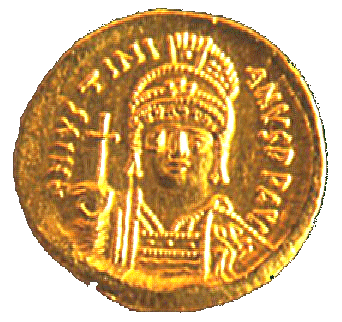|
|
The vision of a universal Empire |

Gold coin of the emperor Justinian I (reigned 527-565).
In the 6th century the generals of Justinian I regained parts of Italy, North Africa and south-eastern Spain, and for a short period it seemed as though the emperors of Constantinople would rule once more over a "universal" Roman empire. By the end of the same century, however, western lands were once more lost to Constantinople. The Slavs and the Avars advanced in the Balkan peninsula, while to the Eastern frontier, the pressure of the Sassanian Empire (the Persians) was ever more threatening. Despite the invasions of Germanic tribes in the West and the alienation between the two parts of the Roman world, archaeological evidence testify that trade routes remained more or less open. A good example is provided by numerous copper-alloy vessels of the same type, manufactured in Egypt and Syria that are found all over Europe.
© 1998 Oxfordshire Museum Service, Setúbal Museums and the Benaki Museum